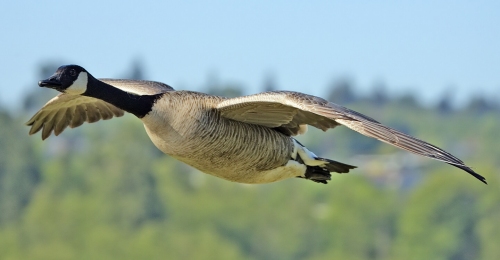Canada Goose (Branta canadensis)
 Canadian Geese on a Lake |
The Canada Goose (Branta canadensis) is a wild goose belonging to the genus Branta, which is native to Arctic and temperate regions of North America, having a black head and neck, white patches on the face, and a brownish-gray body. It is often called the Canadian Goose, but that name is not the ornithological standard, or the most common name.
The black head and neck with white "chinstrap" distinguish the Canada Goose from all other goose species, with the exception of the Barnacle Goose, but the latter has a black breast, and also grey, rather than brownish, body plumage. There are seven subspecies of this bird, of varying sizes and plumage details, but all are recognizable as Canada Geese. Some of the smaller races can be hard to distinguish from the newly-separated Cackling Goose.
 A Goose Takes to the Air |
This species is 30–43 in long with a 50–71 in wingspan. The male usually weighs 7–14 pounds, and can be very aggressive in defending territory. The female looks virtually identical but is slightly lighter at 5.5–12 pounds, generally 10% smaller than its male counterpart, and has a different honk. An exceptionally large male of the race B. c. maxima, the "giant Canada goose" (which rarely exceed 18 lb), weighed 24 pounds and had a wingspan of 88 inches. This specimen is the largest wild goose ever recorded of any species. The life span in the wild is 10–24 years.
In New Jersey, non-migratory Canada Goose populations have been on the rise. The species is frequently found on golf courses, parking lots and urban parks, which would have previously hosted only migratory geese on rare occasions. Owing to its adaptability to human-altered areas, it has become the most common waterfowl species in North America. In many areas, non-migratory Canada Geese are now regarded as pests. They are suspected of being a cause of an increase in high fecal coliforms at beaches. An extended hunting season and the use of noise makers have been used in an attempt to disrupt suspect flocks.
Harbor Wildlife Control has engaged in lethal culls and egg addlig of Canada Geese primarily in urban or densely populated areas. We respond to municipalities or private land owners, such as golf courses, who find the geese obtrusive or object to their waste.
| Middlesex County | Monmouth County | Somerset County | Union County | Warren County |
| Sussex County | Morris County | Essex County | Hudson County | Hunterdon County |
Mercer County and Richmond County (Staten Island), NY